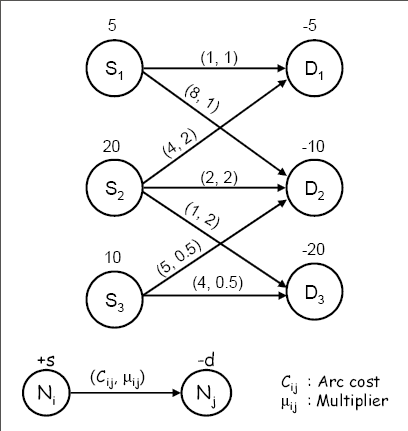| The NETFLOW Procedure |
Example 5.11: Generalized Networks: Using the EXCESS= Option
For generalized networks you can specify either EXCESS=SUPPLY or EXCESS=DEMAND to indicate which nodal flow conservation constraints have slack variables associated with them. The default option is EXCESS=NONE.
Using the EXCESS=SUPPLY Option
Consider the simple network shown in Figure 5.48. As you can see, the sum of positive supdem values (35) is equal to the absolute sum of the negative ones. However, the arcs connecting the supply and demand nodes have varying arc multipliers. Let us now solve the problem using the EXCESS=SUPPLY option.

|
Figure 5.48: Generalized Network: Supply = Demand
You can use the following SAS code to create the input data sets:
data garcs;
input _from_ $ _to_ $ _cost_ _mult_;
datalines;
s1 d1 1 .
s1 d2 8 .
s2 d1 4 2
s2 d2 2 2
s2 d3 1 2
s3 d2 5 0.5
s3 d3 4 0.5
;
data gnodes;
input _node_ $ _sd_ ;
datalines;
s1 5
s2 20
s3 10
d1 -5
d2 -10
d3 -20
;
To solve the problem, use the following call to PROC NETFLOW:
title1 'The NETFLOW Procedure';
proc netflow
arcdata = garcs
nodedata = gnodes
excess = supply
conout = gnetout;
run;
The optimal solution is displayed in Output 5.11.1.
Output 5.11.1: Optimal Solution Obtained Using the EXCESS=SUPPLY OptionNote: If you do not specify the EXCESS= option, or if you specify the EXCESS=DEMAND option, the procedure will declare the problem infeasible. Therefore, in case of real-life problems, you would need to have a little more detail about how the arc multipliers end up affecting the network --- whether they tend to create excess demand or excess supply.
Using the EXCESS=DEMAND Option
Consider the previous example but with a slight modification: the arcs out of node
data garcs1;
input _from_ $ _to_ $ _cost_ _mult_;
datalines;
s1 d1 1 0.5
s1 d2 8 0.5
s2 d1 4 .
s2 d2 2 .
s2 d3 1 .
s3 d2 5 0.5
s3 d3 4 0.5
;
Note that the node data set remains unchanged. You can use the following call to PROC NETFLOW to solve the problem:
title1 'The NETFLOW Procedure';
proc netflow
arcdata = garcs1
nodedata = gnodes
excess = demand
conout = gnetout1;
run;
The optimal solution is displayed in Output 5.11.2.
Output 5.11.2: Optimal Solution Obtained Using the EXCESS=DEMAND Option
|
Copyright © 2008 by SAS Institute Inc., Cary, NC, USA. All rights reserved.